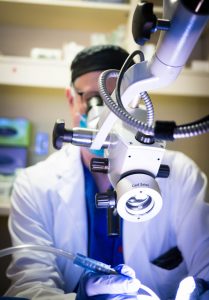Hypopharyngeal Cancer
About
 Cancer of the hypopharynx is also called hypopharyngeal cancer and it can occur in the passageway at the back of the throat that is shared by the nose and the mouth. At its lower end, the hypopharynx opens into the food tube and lies next to the top of the windpipe.
Cancer of the hypopharynx is also called hypopharyngeal cancer and it can occur in the passageway at the back of the throat that is shared by the nose and the mouth. At its lower end, the hypopharynx opens into the food tube and lies next to the top of the windpipe.
People typically first notice a problem because of a lump in the neck, a persistent cough, a sore throat ora sensation that something is caught in the throat. There are also a number of other symptoms associated with this type of cancer that we have listed in this section. Remember that the symptoms you experience might also be caused by other medical conditions so it’s important for you to consult a physician to confirm a diagnosis.
It’s normal for you to wonder how you got cancer of the hypopharynx. Although we still don’t have all the answers, we do know that there are risk factors associated with people developing this cancer, especially age and sex, tobacco and alcohol use, ethnicity, personal history, environmental exposures, and diet. Remember that there is no single cause for developing this type of cancer.
Screening and Diagnosis
 You may need to undergo a number of tests for the screening and diagnosis, which will help your team to assess the stage, or severity of the cancer. Your head and neck specialist will first perform a physical examination to look for signs and symptoms of cancer, and then may order one or more of the most commonly used tests such nasendoscopy, panendoscopy, and x-rays.
You may need to undergo a number of tests for the screening and diagnosis, which will help your team to assess the stage, or severity of the cancer. Your head and neck specialist will first perform a physical examination to look for signs and symptoms of cancer, and then may order one or more of the most commonly used tests such nasendoscopy, panendoscopy, and x-rays.
Learn about some of the other tests commonly used for head and neck cancers
Treatment
Cancers of the hypopharynx are biologically aggressive and have more ability to spread than other types of head and neck cancer. Because most hypopharyngeal tumors grow in a silent fashion without presenting noticeable symptoms, they are often quite large by the time the patient is first seen.
Radiation/Chemotherapy
The majority of patients with this cancer are treated with radiation alone or with chemotherapy. This approach provides the best outcome for protecting speech by preserving the hypopharynx, which is key for sound amplification and the larynx, which is key for speaking. A downside of this approach is that it frequently, although not inevitably, leads to problems with swallowing.
In fact, 10-15% of people treated with radiation or chemotherapy will have significant swallowing problems and will need to modify the nature of their food intake. A small percentage of patients will require the use of a permanent gastric tube placed directly into the abdominal wall.
Surgery
Patients are offered surgery when they have very advanced hypopharyngeal tumors where the larynx is already extensively involved. For these patients, the larynx cannot be saved using radiation alone or with chemotherapy and surgery is the best treatment option.
If hypopharyngeal cancer returns after radiation alone or with chemotherapy, patients are offered surgery to remove portions or all of the hypopharynx or larynx. In such cases, reconstructive surgery will be necessary.
Early and Late Stage Cancer of the Hypopharynx
The surgical approaches to treating hypopharyngeal cancer will depend on the whether the cancer is at an early or late stage of development. Small, early-stage tumors are typically treated with radiation or by transoral laser. During the transoral laser procedure, a viewing tool called a laryngoscope is placed into the patient’s mouth to help the surgeon see the cancer and remove it using the laser.
Larger tumors that occur during later stages of hypopharyngeal cancer are treated with radical surgery followed by radiation treatment. It is not uncommon for the larynx to also be involved and because of that, part or all of the larynx is also removed during the radical surgery for hypopharyngeal cancer. If the entire larynx is removed, patients will have a permanent hole in the neck, called a stoma, and will no longer be able to breath through the nose but will breathe through the stoma. These patients will require reconstructive surgery to rebuild the hyphopharynx and preserve its role in swallowing.
The majority of patients with late stage hypopharyngeal cancer will also require neck dissection surgery where the lymph nodes close to the cancer are removed and then assessed by a pathologist. Incases where multiple lymph nodes test positive or where the hypopharyngeal cancer is growing along nearby nerves, patients are treated with radiation and/or chemotherapy after surgery.
Depending on the complexity of the surgery, patients will be left with either a straight-line excision across the neck, a side-to-side excision, or a U-shaped incision from ear to ear that includes the stoma.
Surgical Complications of Total Laryngectomy
If the throat area does not heal properly following removal of the larynx, some patients may develop what is called a fistula. When that happens, an unwanted connection between the throat and the outside skin of the neck develops that may allow saliva or food to leak out onto the skin or space between the throat and the neck. In such cases, careful wound management on the part of the nurses and head and neck specialist may be enough to help the area to heal. If further measures are needed, surgeons may attempt to reconstruct the area using free or attached flaps. Patients who experience this complication will require longer hospital stays, longer recovery times to swallow normally and will have to wear a tracheostomy tube for 2-4 weeks. With the help of a speech pathologist, patients may regain speech by 3-4 weeks after surgery.
Preparing for Your Surgery
Prior to surgery, all patients will have an appointment at the pre-admission clinic located at the Toronto General Hospital. You must bring all the information about recent medical tests, as well as the names and phone numbers of physicians you have seen in the past. A pre-admission nurse will perform the admission, assessment and blood work, usually 2-3 weeks before the surgery.
A clinical nurse coordinator will supervise the preadmission appointment, explain the information about your surgery, introduce you to the staff and take you on a tour of the surgical inpatient unit if you request it. The pre-admission clinic is responsible for providing all tests, assessments and educational information to patients and family members before the scheduled surgery.
Starting at midnight on the night before your surgery, you must not eat, drink, chew or suck on candies as it is of the utmost importance that your stomach be empty when you have your surgery.
On the morning of your surgery, you must arrive at the hospital 2 hours before the scheduled surgery time. The preadmission nurse and nursing staff will prepare you for surgery, and insert an intravenous (IV) needle that will allow fluids, antibiotics and pain medications to be injected into your blood during the surgery.
During Your Surgery
When the tumor is removed, the head and neck surgeon will also remove a 1.5 cm section of tissue surrounding the tumor. This tissue is immediately frozen and cut into sections so that a pathologist can identify whether the tissue surrounding the tumor edges is normal or cancerous.
The head and neck surgeon will await the pathologist’s diagnosis before completing the surgery. The pathologist will give a diagnosis of ‘negative margins’ when the thin slice of tissue surrounding the tumor contains only normal cells.
Alternatively, the pathologist will give a diagnosis of ‘positive margins’ if cancer cells are observed in the thin slice of tissue surrounding the tumor. In the case of a ‘positive margin’ diagnosis, the head and neck surgeon will remove additional tissue at the tumor site before completing the surgery. The additional tissue is frozen, cut into sections and sent to a pathologist to check for cancer cells. Patients will be informed of the results during their first visit with their oncology surgeon.
Your Recovery
When the surgery is finished, you will be taken to the recovery room. If it is safe to transfer you once you are awake, you will be taken to the Head and Neck surgical ward. If you require more attention, you will be transferred to the Step Down Unit where you will be closely monitored by a nurse. In theStep Down Unit you may find that you are attached to a number of tubes.
Your Pain Management
Your multidisciplinary treatment team will make it a priority to ensure that you are not in pain after surgery.During recovery, patients are able to manage their own pain using PCA (patient controlled analgesia). The word ‘analgesia’ means ‘without pain’ and an ‘analgesic’ is any medication that relieves pain. When patients are in pain, they simply press a button to immediately receive a dose of pain medication. Both the dose and number of times a patient can push the button each minute are preset by the nursing staff who follows the instructions of the patient’s head and neck specialist.The medication is usually delivered either into a vein (intravenously), under the skin (subcutaneously) or between outside of the brain and skull (epidurally). Although the medication dose is typically low, patients can press the button frequently enough to maintain an even level of pain medication that brings sustained relief to their bodies over time.
Returning Home after Your Surgery
You may need to stay in the hospital for 3-14 days, depending on the speed of your recovery or the complications that resulted from surgery. For more complicated surgical procedures, the hospital stay is typically 10-14 days.
During your stay at the hospital, you may need to be given a liquid orminced diet until you are able to swallow normally. When you leave the hospital, you should have very little pain and be able to eat and breathe on your own.
For minor surgical procedures, speech should return within 3-4 weeks. However, if patients undergo a total laryngectomy, they will require speech rehabilitation with the assistance of a speech pathologist.
During your stay in the hospital and also when you return home, you may need to work with a number of specialists to restore normal function to your body. A speech pathologist will help you deal with difficulties in speaking, swallowing, and chewing. A physiotherapist will help you to strengthen the muscles that may have been affected as a result of your treatment. Your head and neck specialist will refer you to these specialists.
The Nurse Coordinator will help you to get ready to return home. You may need a nurse to visit you at home, and you may need to consider getting help with other issues such as smoking, drinking heavily, returning to normal activities, managing pain, and diet. Your multidisciplinary health care team will provide you with guidance and make recommendations to other specialists to help you tackle these issues.
Rehabilitation
Depending on the treatments needed, you may have to undergo a period of rehabilitation to help restore the function of the hypopharynx. Various members of the multidisciplinary treatment team, such a physiotherapists and speech therapists, will be involved in your ongoing rehabilitation to help you regain swallowing movement and/or speech. These individuals will also make referrals for community support upon your return home.
Speech Therapy and Communication Options Post – Surgery
Patients who have been treated for hypopharyngeal cancer may require the ongoing assistance of a speech therapist to help them regain their normal speaking patterns, or learn how to use new techniques and devices that are intended to replace the larynx if it had to be removed during surgery. There are a number of communication options available to patients following surgery, including:
Writing pad
This option is where patients write their thoughts down on a writing pad.
Electolarynx
This device is held under the jaw and acts as a mechanical larynx byproducing vibrations that are create sound when words are made.
Esophageal speech
This is a technique where patients learn to swallow air and release it back up through the foodtube (esophagus) to create vibrations and sounds.
Tracheoesophageal puncture (TEP)
This is the most popular method for creating speech in patients who have had a total laryngectomy. The tracheoesophagel puncture (TEP) is a small hole made between the windpipe and foodtube. The valve (voice prosthesis)placed in the hole isa one way device that allows air from the lungs to pass into the food tube but prevents food from entering the windpipe.
When the larynx is removed, a hole (stoma) is created at the neck and that is how patients breathe. To use a TEP to speak, patients will place their handover the stoma at the neck, and exhale air from the lungs. The air will travel up the windpipe and through the TEP into the foodtube which will vibrate and allow sounds to be made for speaking.
With assistance from a speech pathologist, patients may regain their speech in 3-4 weeks.Patients who are going to have a TEP will not need to have anasogastric feeding tube.Instead, a feeding tube is passed through the stoma and when patients can eat normally, the feeding tube is replaced with the TEP.
Follow-Up Care
 Patients who have had cancer of the hypopharynx will need to be closely monitored for the rest of their lives. During regular check-ups your doctor will evaluate your general health and assess whether the cancer treatments were effective. It may be necessary to have repeat blood tests and/or diagnostic tests to check for the recurrence of cancer.
Patients who have had cancer of the hypopharynx will need to be closely monitored for the rest of their lives. During regular check-ups your doctor will evaluate your general health and assess whether the cancer treatments were effective. It may be necessary to have repeat blood tests and/or diagnostic tests to check for the recurrence of cancer.
Remember to monitor how your body feels so that you can let your doctor(s) know during the regular check-ups about any changes that are worrisome, such as:
- constant pains
- unexplained weight loss
- lumps, rashes, bruises, swellings, bleeding
- fever, cough, or persistent hoarseness
